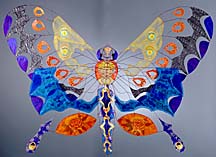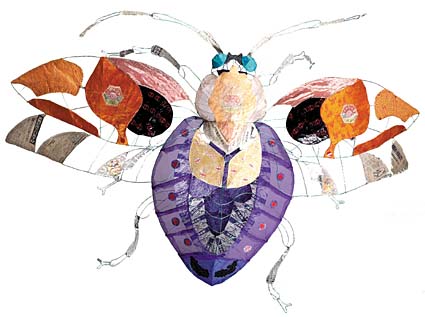
GEORGE R. YOUNG PHOTOS COURTESY CORINNE OKADA TAKARA
A portrait of artist Corinne Okada Takara in her Rolling Ball Hat ($150) -- yes the ball in front is meant to roll in its wire "track"Scratch paper
Corinne Takara Okada takes
childhood lessons to heart in
turning odds and ends into
whimsical pieces of art
Corinne Okada Takara's living room didn't look like all the other kids' in the mainland neighborhoods where she grew up.
GEORGE R. YOUNG PHOTOS COURTESY CORINNE OKADA TAKARA
Corinne Okada Takara
Exhibition of paper sculptures:Where: C.S. Wo Gallery, 702 S. Beretania St.
When: 10 a.m. to 7 p.m. today and tomorrow, 10 a.m. to 6 p.m. Saturday and Sunday
Admission: Free
Call: 543-5388
Quotable: "I appreciate the way people were able to use what they had to create something beautiful, how they'd make clothes with rice bags, and occasionally you would see a patch of a beautiful silk kimono that would be part of something really special."
She's since realized most people don't have a giant hippo couch, complete with foam teeth that she crawled through to make a home in the creature's belly. But back then her father's carpet-patch creation -- a child's couch that was the result of a product design master's-degree project -- seemed normal.
Looking back, Takara says: "My poor mom! Imagine that sitting in the living room everywhere we lived."
Things got even stranger during the family's almost annual visits to Hawaii to catch up with relatives on Oahu and Paia, Maui, where David Okada grew up, a plantation boy through and through.
"I don't think my dad even wore shoes until junior high," says Takara, who listened in amazement to elders talking story.
"They were storytellers and would always talk about the good old days, about eating things like grubs off wood sticks and say they feel sorry for kids today who don't grow up with that."
She also learned the No. 1 plantation household rule: Don't throw anything away, because everything has a purpose.
"My great-auntie had a drawer for plastic bags and another for plastic bags with holes in them. If they caught me throwing away aluminum foil, they'd tell me to wash it and hang it out to dry. It was funny to see all the plastic bags and foil flapping in the wind.
"I don't think that people in Hawaii realize it's kind of a unique thing. The only other place I've seen that is in the South, where they also had a plantation history.
"I appreciate the way people were able to use what they had to create something beautiful, how they'd make clothes with rice bags, and occasionally you would see a patch of a beautiful silk kimono that would be part of something really special."
Takara took these lessons to heart in turning scrap pieces of fabric, plastic netting, and milk candy and crack seed wrappers into whimsical paper-and-wire sculptures and wearable hats. A few of her works are on view at C.S. Wo through Sunday.
TAKARA didn't start as a recycle artist. She began her career in the arts as a commercial illustrator and graphic designer, focusing on corporate identity for the high-tech industry in San Francisco, where she still resides.
GEORGE R. YOUNG PHOTOS COURTESY CORINNE OKADA TAKARA
Takara's Milky Candy Flower Hat ($170)
That changed four years ago when she gave birth to her son and wanted to devote more time to him. The timing, coinciding with the tech bust, couldn't have been better.
"Even it I had tried to stay in it, I wouldn't have found work," she said, turning her attention to more personal art pursuits.
She started working with commercial papers but was drawn to the translucent quality of the Chan Pan Mui and blue rabbit illustration of the milk candy wrappers that also reflected her Japanese heritage and Hawaii ties. Fixed in her imagination were tales of apple wrappers folded into kimonos for homemade dolls, airport greetings marked by an exchange of crack seed leis, and patchwork blankets stitched from hundreds of tiny Bull Durham tobacco bags.
"My father made all his own toys," she said, including boats made of leaves and pinwheels of flowers. He grew up to be a head designer at toy giant Kenner and senior vice president of product design at Mattel.
Creativity at home was encouraged, and at Halloween time, Takara never had to go trick-or-treating in a store-bought costume. She remembers her dad helping her to make a frog mask out of a foam cooler covered with papier-mâché.
"I was so young I thought I made it, but really, he made it."
TAKARA DIDN'T HAVE to wait long to attract an audience. Her first step was to contact Union Square stores with window displays. Tiffany was staging an insect-inspired jewelry display, and it was a natural fit for Takara's butterfly and dragonfly sculptures.
GEORGE R. YOUNG PHOTOS COURTESY CORINNE OKADA TAKARA
Orchid hair ornament ($150)
A gallery curator saw her work and invited her to show, which led to more displays in Boston, New York and Florida.
Eventually, the translucent quality of the wrappers she was using led her to think of Cinderella's glass slipper, and this resulted in a series of single shoes, all full of possibilities of one day finding a home on a princess's foot. Some have found homes in the private collections of the head curator of the Peabody Essex Museum and other private collections.
Although the shoes are not meant to be worn, Takara's hats, inspired by Japanese kanzashi hair ornaments and Okinawan dance hats, have made many an appearance at San Francisco social events.
The first hat she created was a gift for French couturier Christian Lacroix, who made an appearance at Neiman Marcus San Francisco in February 2001.
GEORGE R. YOUNG PHOTOS COURTESY CORINNE OKADA TAKARA
Milk Candy Shoe sculpture ($400).
Takara had created the sculptural display as a backdrop to his fashion show, and afterward the designer returned twice to photograph her work. She responded by sending him a large paper-and-wire flower hat in the style of her sculptures, for which she received a thank-you letter that she keeps in her studio.
Her family remains encouraging, plying her with papers from candy and crack seed they have consumed. Her husband, Kurt, who grew up in Nuuanu, also eats his share of crack seed, but recently, she says she's been naughty, buying certain seeds more for their wrappers than their edible qualities.
The couple didn't care for a certain apricot-lemon combination, but with the wastefulness taboo, they groaned through the mouthfuls, "Ohh, gotta eat those."
GEORGE R. YOUNG PHOTOS COURTESY CORINNE OKADA TAKARA
The Flying Beetle measures about 6-by-4 feet; $2,000.
Click for online
calendars and events.






